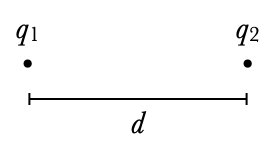Coulomb's Law

Suppose you have two point charges* a distance $d$ from each other. What force do they exert on each other? We know what direction these forces will be: they will be pushed apart if the charges have the same sign, and pulled together if the charges have opposite sign. The magnitude of this force is given by an equation called Coulomb’s Law:
Notice that this formula tells you the force on either charge: according to Newton’s Third Law, both charges feel the same magnitude of force, only in opposite directions. The fundamental constant $k=9\ten9\u{Nm^2/C^2}$ is sometimes called Coulomb’s constant.

Suppose I hold two $q=-1\u{C}$ charges in my hands so that they are 0.3m apart (about a foot). What force do they feel from each other? They have the same sign, so they will repel each other. The magnitude of that force is $$\begin{align} F&=k\abs{q_1q_2\over d^2}\\ &=\left(9\times 10^9\u{Nm^2\over C^2}\right){\abs{(-1\u{C})(-1\u{C})}\over (0.3\u{m})^2}\\ &= 1\ten{11}\u{N}\\ \end{align}$$ which is 100 billion newtons! This is a huge force: if I were holding these two charges, I wouldn't be holding them for long!
Coulombs are very large charges, in other words, and we will more often see smaller charges like microcoulombs ($1\u{\mu C}=10^{-6}\u{C}$) or nanocoulombs ($1\u{nC}=10^{-9}\u{C}$).
Remember that this equation only gives you the magnitude of the force. Since force is a vector, you will need to supply the direction yourself, via the rule "likes repel, opposites attract".
If there are more than two charges, then we usually specify one charge to be the target charge: that is, the charge on which we are calculating the force. The other charges are then considered source charges. We then calculate the force $\vec F$ on the target due to each source individually, and then add them to find the net force: $$\vec F=\vec F_1+\vec F_2+\dots$$ However, we must add them as vectors, taking their directions into account.